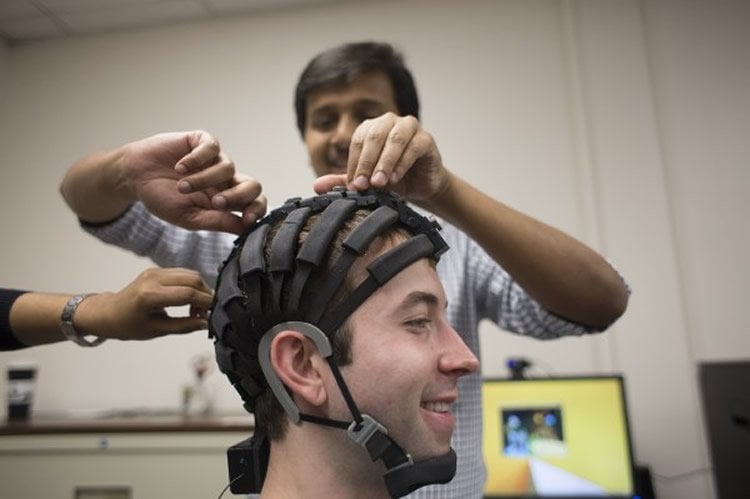Summary: Researchers look to neuroimaging and EEG technology to improve market research.
Source: Missouri University of Science and Technology.
A researcher at Missouri University of Science and Technology wants to scrap the traditional electronic and paper survey approaches to gathering marketing and information systems data in favor of scanning your brainwaves.
Dr. Keng Siau, professor and chair of the business and information technology department, is looking at using an electroencephalogram (EEG) headset to pick your brain. He and a former graduate student compared the pros and cons of EEG and other neurophysiological for a paper published last January in the Journal of Database Management.
An EEG tracks and records brain wave patterns. Small metal discs with thin wires (electrodes) are placed on the scalp and send signals to a computer to record the results.
“We’re actually trying to go deeper inside,” Siau says. “Because when you ask someone to fill out a questionnaire, there are a few issues.”
Chief among them, he says, are time and accuracy.
“I receive a lot of questionnaires. But do I have time to fill them out? Most of the time, I don’t. I just put them aside,” says Siau.
He uses the common problem of getting accurate survey responses as an example.
“A lot of times, we want to get information from CEOs, but CEOs don’t have the time and just pass it to their secretaries,” Siau says. “The secretaries are the ones that fill out the questionnaires, not the CEOs. A secretary’s opinion will be somewhat different from the opinion of a CEO.”
Siau also says that people often answer survey questions based on what they think the surveyor wants to hear.
“‘This is what I think, but this is what they want. OK, I’ll give them what they want’,” he says. “When I look at something, maybe I have a first response. But then I think maybe people want to hear this answer and not that one.”
When an individual’s brain activity is monitored, however, “it’s harder to lie, it’s more instantaneous and unfiltered,” Siau adds.
Cognitive neuroscience is an emerging field in information systems and marketing research. Siau and his former research assistant, Yeli Zhao, who recently graduated with an MBA and is now working at the Chinese University of Petroleum in Beijing, reviewed several neurophysiological tools used in this field. Their review included the EGG, as well as functional MRI (fMRI), positron emission tomography (PET) and magnetoencephalography (MEG). They outlined the strengths and weaknesses of each tool and highlighted future research directions in cognitive neuroscience in their review article “Cognitive Neuroscience in Information Systems Research,” published in the January 2016 edition of the Journal of Database Management.

As expected, Siau and Zhao found a strong correlation between cost and effectiveness among the tools. For example, an EEG headset can only scan the surface of the brain, while a functional MRI can penetrate deeper into the brain to retrieve thoughts and emotions. But at $50,000, the cost of a good quality EEG headset is relatively cheap compared to a state-of-the-art MRI scanner, which goes for about $2 million to $3 million.
Siau called the comparative and review research “a starting point.”
“It’s a new way of thinking about and researching previous research questions,” he says. “We have been using surveys as a technique for data collection. Now we have a new technique called cognitive neuroscience that will look at brain activity.
“It opens up new dimensions to study cognition in information systems research,” he adds.
Source: Andrew Careaga – Missouri University of Science and Technology
Image Source: NeuroscienceNews.com image is credited to Missouri University of Science and Technology.
Original Research: Abstract for “Cognitive Neuroscience in Information Systems Research” by Yeli Zhao and Keng Siau in Journal of Database Management. Published online December 3 2016 doi:10.4018/JDM.2016010103
[cbtabs][cbtab title=”MLA”]Missouri University of Science and Technology. “Electronically Picking Your Brain – For Market Research.” NeuroscienceNews. NeuroscienceNews, 3 December 2016.
<https://neurosciencenews.com/neuromarketing-eeg-5666/>.[/cbtab][cbtab title=”APA”]Missouri University of Science and Technology. (2016, December 3). Electronically Picking Your Brain – For Market Research. NeuroscienceNews. Retrieved December 3, 2016 from https://neurosciencenews.com/neuromarketing-eeg-5666/[/cbtab][cbtab title=”Chicago”]Missouri University of Science and Technology. “Electronically Picking Your Brain – For Market Research.” https://neurosciencenews.com/neuromarketing-eeg-5666/ (accessed December 3, 2016).[/cbtab][/cbtabs]
Abstract
Cognitive Neuroscience in Information Systems Research
This paper reviews cognitive neuroscience and several neurophysiological tools (e.g., fMRI, PET, EEG, MEG, and eye tracking). The strengths and weaknesses of such tools for information systems research are presented. The paper provides examples of existing cognitive neuroscience studies in varies areas, such as neuroeconomics, neuromarketing, and eye tracking. In addition, this paper provides an overview of brain areas that response to various mental processes, and discusses the localization and functionality of each brain area. Because of the popularity of eye-tracking research in information systems, measurements and metrics related and derived from eye-tracking technique (e.g., fixation, saccades and scanpath) are described and discussed in this paper. Opportunities for applying cognitive neuroscience techniques to IS research as well as future research directions are also discussed.
“Cognitive Neuroscience in Information Systems Research” by Yeli Zhao and Keng Siau in Journal of Database Management. Published online December 3 2016 doi:10.4018/JDM.2016010103







